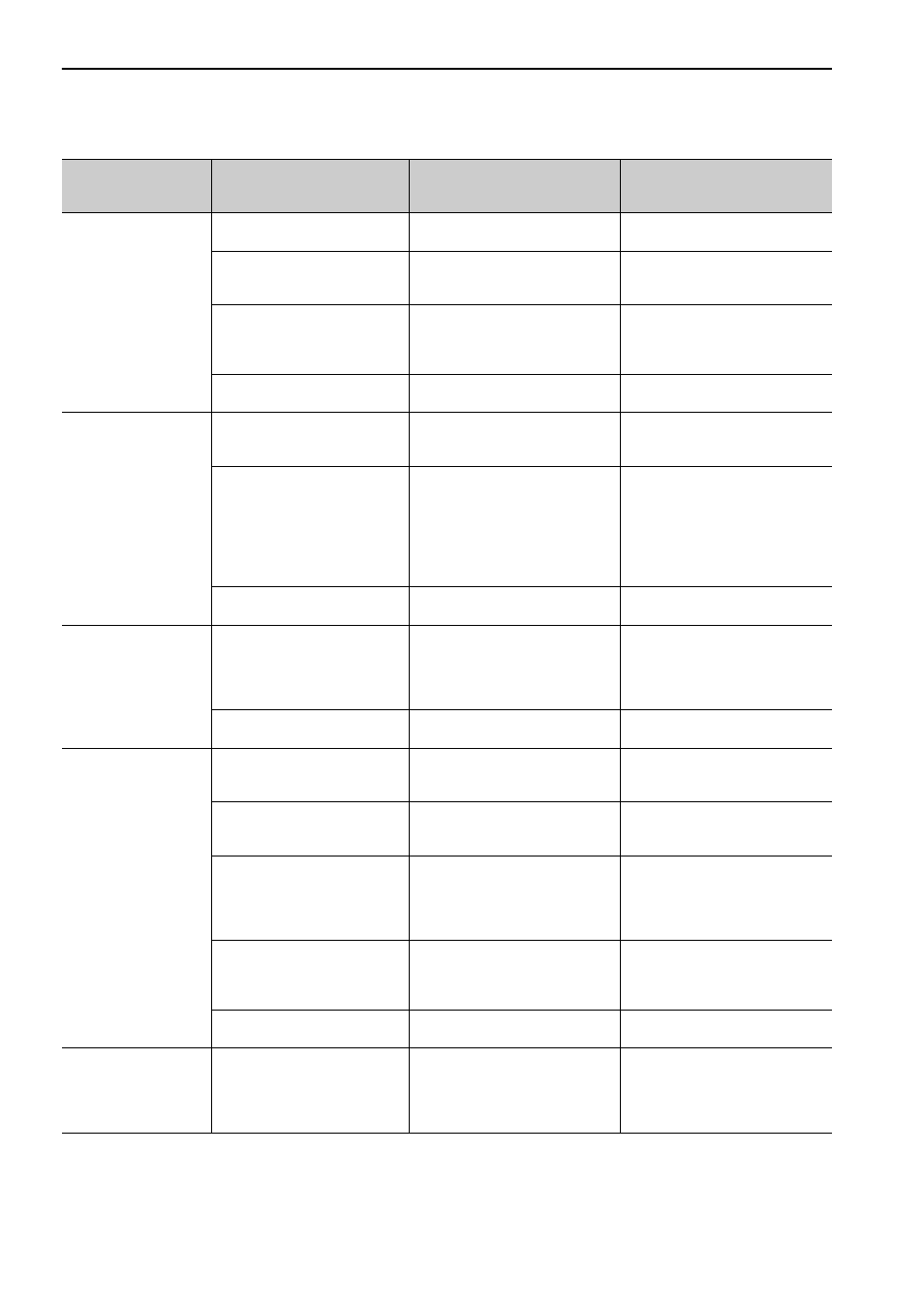Yaskawa Sigma-5 User Manual: Design and Maintenance - Rotary Motors - Analog Voltage and Pulse Train Reference User Manual
Page 359

10 Troubleshooting
10.1.2 Troubleshooting of Alarms
10-12
A.710:
A.720:
Overload
A.710: High Load
A.720: Low Load
Incorrect wiring or contact fault
of servomotor and encoder.
Check the wiring.
Confirm that the servomotor and
encoder are correctly wired.
Operation beyond the overload
protection characteristics.
Check the servomotor overload
characteristics and executed run
command.
Reconsider the load conditions and
operating conditions. Or, increase
the motor capacity.
Excessive load was applied dur-
ing operation because the servo-
motor was not driven due to
mechanical problems.
Check the executed operation refer-
ence and motor speed.
Remove the mechanical problems.
A SERVOPACK fault occurred.
−
The SERVOPACK may be faulty.
Replace the SERVOPACK.
A.730:
A.731:
Dynamic Brake Over-
load
(An excessive power
consumption of dynamic
brake was detected.)
The servomotor rotates because
of external force.
Check the operation status.
Take measures to ensure the servo-
motor will not rotate because of
external force.
The rotating energy at a DB stop
exceeds the DB resistance capac-
ity.
Check the power consumed by DB
resistance (Un00B) to see how
many times the DB has been used.
Reconsider the following:
• Reduce the motor reference
speed.
• Reduce the moment of inertia
ratio.
• Reduce the number of times of
the DB stop operation.
A SERVOPACK fault occurred.
−
The SERVOPACK may be faulty.
Replace the SERVOPACK.
A.740:
Overload of Surge
Current Limit Resistor
(The main circuit power
is turned ON/OFF too
frequently.)
The inrush current limit resistor
operation frequency at the main
circuit power supply ON/OFF
operation exceeds the allowable
range.
−
Reduce the frequency of turning the
main circuit power supply ON/OFF.
A SERVOPACK fault occurred.
−
The SERVOPACK may be faulty.
Replace the SERVOPACK.
A.7A0:
Heat Sink Overheated
(Detected when the heat
sink temperature
exceeds 100
°C.)
The surrounding air temperature
is too high.
Check the surrounding air tempera-
ture using a thermostat.
Decrease the surrounding air tem-
perature by improving the SERVO-
PACK installation conditions.
The overload alarm has been
reset by turning OFF the power
too many times.
Check the alarm history display
(Fn000) to see if the overload alarm
was reported.
Change the method for resetting the
alarm.
Excessive load or operation
beyond the regenerative energy
processing capacity.
Check the accumulated load ratio
(Un009) to see the load during oper-
ation, and the regenerative load
ratio (Un00A) to see the regenera-
tive energy processing capacity.
Reconsider the load and operating
conditions.
Incorrect SERVOPACK installa-
tion orientation or/and insuffi-
cient space around the
SERVOPACK.
Check the SERVOPACK installa-
tion conditions.
Install the SERVOPACK correctly
as specified.
A SERVOPACK fault occurred.
−
The SERVOPACK may be faulty.
Replace the SERVOPACK.
A.7AB:
Built-in Fan in SER-
VOPACK Stopped
The fan inside the SERVOPACK
stopped.
Check for foreign matter or debris
inside the SERVOPACK.
Remove foreign matter or debris
from the SERVOPACK. If the
alarm still occurs, the SERVO-
PACK may be faulty. Replace the
SERVOPACK.
(cont’d)
Alarm Number:
Alarm Name
(Alarm Description)
Cause
Investigative Actions
Corrective Actions
